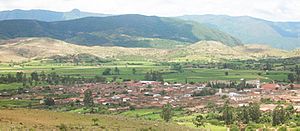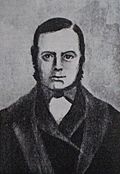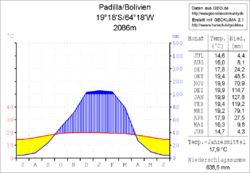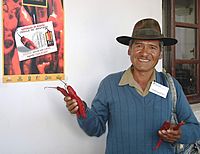Padilla, Bolivia facts for kids
Quick facts for kids
Padilla
|
|
|---|---|
|
Town
|
|
 |
|
| Country | |
| Department | Chuquisaca |
| Province | Tomina |
| Municipality | Padilla |
| Founded | June 23, 1583 |
| Elevation | 6,844 ft (2,086 m) |
| Population
(2010)
|
|
| • Total | 3,697 |
| Time zone | UTC-4 (BOT) |
Padilla is a small town in the Chuquisaca Department of Bolivia. It is located in the southeastern part of the country. This town is the main center of the Padilla municipality. In 2010, about 3,697 people lived here. Padilla has a rich history and a unique culture.
Contents
History of Padilla: A Town of Many Names
Padilla was founded a long time ago, on June 23, 1583. It was first called San Miguel de La Laguna. The town was built as a fort to protect against attacks from the Chiriguanos, who were Guaraní warriors.
After being destroyed once, the Spanish rebuilt it. They renamed it San Juan de Rodas. But soon, its name changed back to La Laguna. This town was very important for stopping invasions by indigenous groups. Over time, it became the main center for military, government, and religious leaders in the Tomina Province.
In 1809, Padilla became a key place for a guerrilla leader named Manuel Ascencio Padilla. He was a hero who fought for Bolivia's independence. His wife, Juana Azurduy de Padilla, also fought alongside him. They both cared deeply for the local people of Bolivia. In 1827, the town was officially renamed Padilla to honor Manuel Ascencio Padilla.
Geography and Climate of Padilla
Padilla is located along Highway 6. It is about 187 kilometers (116 miles) from Sucre, which is one of Bolivia's capitals. East of the town, you can find the Rio Grande Mascicuri Forest Reserve. The whole municipality of Padilla covers a large area of 1,617 square kilometers (624 square miles). About 12,562 people live in this wider area.
The town sits at an altitude of 2,086 meters (6,844 feet) above sea level. This is where the Andean mountains meet the lowlands of Bolivia. The weather in Padilla is usually mild. The average temperature is around 18°C (64°F). It doesn't change much throughout the year. The driest months are from May to August.
| Climate data for Padilla, elevation 2,080 m (6,820 ft), (2003–2012) | |||||||||||||
|---|---|---|---|---|---|---|---|---|---|---|---|---|---|
| Month | Jan | Feb | Mar | Apr | May | Jun | Jul | Aug | Sep | Oct | Nov | Dec | Year |
| Mean daily maximum °C (°F) | 24.8 (76.6) |
24.5 (76.1) |
24.5 (76.1) |
23.5 (74.3) |
22.3 (72.1) |
23.7 (74.7) |
23.2 (73.8) |
24.0 (75.2) |
24.4 (75.9) |
25.4 (77.7) |
25.8 (78.4) |
25.2 (77.4) |
24.3 (75.7) |
| Daily mean °C (°F) | 18.9 (66.0) |
18.6 (65.5) |
18.4 (65.1) |
17.0 (62.6) |
14.2 (57.6) |
14.2 (57.6) |
13.6 (56.5) |
14.5 (58.1) |
15.8 (60.4) |
18.2 (64.8) |
18.9 (66.0) |
19.4 (66.9) |
16.8 (62.3) |
| Mean daily minimum °C (°F) | 12.9 (55.2) |
12.8 (55.0) |
12.3 (54.1) |
10.5 (50.9) |
6.0 (42.8) |
4.8 (40.6) |
4.1 (39.4) |
5.1 (41.2) |
7.3 (45.1) |
11.0 (51.8) |
12.0 (53.6) |
13.7 (56.7) |
9.4 (48.9) |
| Average precipitation mm (inches) | 122.1 (4.81) |
101.1 (3.98) |
80.1 (3.15) |
29.0 (1.14) |
9.2 (0.36) |
2.3 (0.09) |
6.3 (0.25) |
2.6 (0.10) |
19.3 (0.76) |
36.4 (1.43) |
53.5 (2.11) |
99.6 (3.92) |
561.5 (22.1) |
| Average precipitation days | 13.0 | 11.9 | 9.6 | 7.9 | 4.8 | 3.1 | 2.1 | 1.8 | 4.2 | 9.2 | 8.0 | 12.4 | 88 |
| Source: Servicio Nacional de Meteorología e Hidrología de Bolivia | |||||||||||||
Economy and Agriculture
The economy in Padilla is mostly based on traditional farming. Farmers grow many different crops. These include corn, potatoes, beans, wheat, yuca, and amaranth.
Padilla is especially famous for its high-quality red Chili peppers. Each year, the town celebrates its peppers at the International Red Chili Pepper Festival. Raising goats is also an important part of the local economy.
Culture and Community Life
The people of Padilla are mostly mestizo. This means they have mixed heritage, often from Spanish families and Quechua people from nearby areas. In the eastern and southern parts of the municipality, there is also a significant Guarani population.
The town has important services for its residents. These include water, electricity, and sewage systems. There are also health centers, TV signals, and internet services. People can use cell phones, and there is a local radio station. Padilla also has places for tourists to stay.
Music is a big part of Padilla's culture. The town has its own composers and musicians. They often perform at the traditional carnival. One famous composer is Prof. Moses Avilés Palma. He wrote the words and music for Ode to Padilla and also composed Padillita.
Notable People from Padilla
Padilla is the birthplace of Celso Torrelio. He became the 57th President of Bolivia.
See also
 In Spanish: Padilla (Bolivia) para niños
In Spanish: Padilla (Bolivia) para niños





